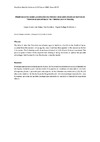Identificador persistente para citar o vincular este elemento:
https://accedacris.ulpgc.es/jspui/handle/10553/19923
| Campo DC | Valor | idioma |
|---|---|---|
| dc.contributor.author | López-Jurado, Luis Felipe | en_US |
| dc.contributor.author | Ruiz, Miguel | en_US |
| dc.contributor.author | Gallego-Huidobro, J. | en_US |
| dc.date.accessioned | 2017-01-18T03:31:06Z | - |
| dc.date.accessioned | 2018-06-18T06:45:48Z | - |
| dc.date.available | 2017-01-18T03:31:06Z | - |
| dc.date.available | 2018-06-18T06:45:48Z | - |
| dc.date.issued | 1982 | en_US |
| dc.identifier.issn | 0173-5373 | en_US |
| dc.identifier.uri | https://accedacris.ulpgc.es/handle/10553/19923 | - |
| dc.description.abstract | El tiempo que tardan en eclosionar los huevos de Tarentola mauritanica en una localidad del sur de España contando a partir del momento de la puesta, ha resultado ser muy inferior al citado al respecto y hasta el presente para esta especie. Se han obtenido resultados de 4, 5, 8, 10 y 12 días como máximo. Se discute la probable generalización de ésta estrategia reproductiva para la especie, así como las posibles ventajas que presenta con respecto al modelo de oviparidad clásico. | en_US |
| dc.description.abstract | The time it takes the Tarentola mauritanica eggs to hatch in a locality in the South of Spain, counted from the moment of laying, has been much less than quoted in this respect so far for this species. The following results have been obtained: 4, 5, 8, 10 and 12 days (maximum). The possible generalization of this reproductive strategy is being discussed, as well as the possible advantages that it presents over the classical oviparity model. | en_US |
| dc.format | application/pdf | - |
| dc.language | eng | en_US |
| dc.relation.ispartof | Amphibia - Reptilia | en_US |
| dc.source | Amphibia - Reptilia [ISSN: 0173-5373], v. 3 (1), p. 65-70 | en_US |
| dc.subject | 24 Ciencias de la vida | en_US |
| dc.subject | 2401 Biología animal (zoología) | en_US |
| dc.subject | 240116 Herpetología | en_US |
| dc.subject.other | Tarentola mauritacnica | en_US |
| dc.title | Primeros datos sobre la duración del periodo de incubación de los huevos de Tarentola mauritanica en Córdoba (sur de España) | en_US |
| dc.type | info:eu-repo/semantics/article | en_US |
| dc.type | Article | en_US |
| dc.identifier.doi | 10.1163/156853882X00176 | en_US |
| dc.identifier.scopus | 0020419476 | - |
| dc.contributor.authorscopusid | 6603237373 | - |
| dc.contributor.authorscopusid | 57085321600 | - |
| dc.contributor.authorscopusid | 57203072224 | - |
| dc.description.lastpage | 70 | - |
| dc.description.firstpage | 65 | - |
| dc.relation.volume | 3 | - |
| dc.investigacion | Ciencias | en_US |
| dc.rights.accessrights | info:eu-repo/semantics/openAccess | - |
| dc.type2 | Artículo | en_US |
| dc.utils.revision | Sí | en_US |
| dc.identifier.ulpgc | Sí | es |
| dc.description.scie | SCIE | |
| item.fulltext | Con texto completo | - |
| item.grantfulltext | open | - |
| crisitem.author.orcid | 0000-0001-6380-6130 | - |
| crisitem.author.fullName | López Jurado, Luis Felipe | - |
| Colección: | Artículos | |
Visitas
99
actualizado el 09-sep-2023
Descargas
183
actualizado el 09-sep-2023
Google ScholarTM
Verifica
Altmetric
Comparte
Exporta metadatos
Los elementos en ULPGC accedaCRIS están protegidos por derechos de autor con todos los derechos reservados, a menos que se indique lo contrario.
